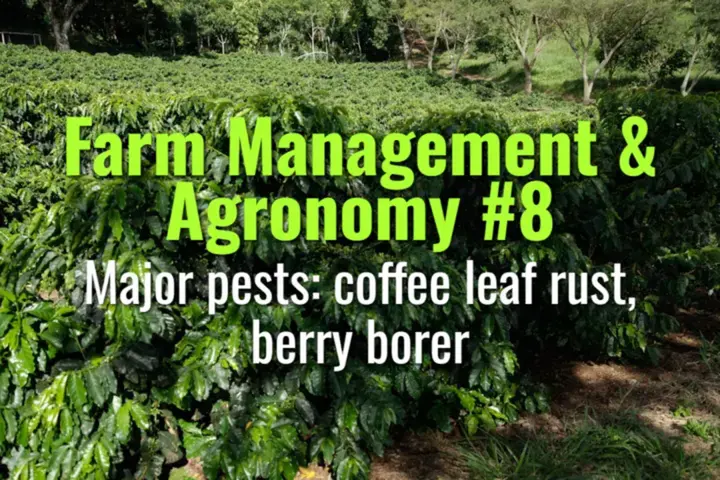Major pests: coffee leaf rust, berry borer
This topic introduces the two most destructive coffee pests worldwide—coffee leaf rust (CLR) and coffee berry borer (CBB)—their biology, symptoms, and management strategies.
- Coffee Basics Nerds
- 2 min read
Article 8 of 12 in Farm Management & Agronomy/

Coffee Leaf Rust (CLR)
- Pathogen: Hemileia vastatrix, a fungal disease first recorded in Sri Lanka (1869), now widespread in all coffee regions.
- Symptoms:
- Yellow-orange powdery lesions on underside of leaves.
- Premature leaf drop, defoliation.
- Reduced photosynthesis, weakening trees.
- Impact:
- Severe outbreaks cause yield losses of 30–80%.
- Long-term weakening reduces lifespan and productivity of trees.
- Favorable conditions: Warm, humid climates (20–28°C, >70% humidity).
- Management:
- Resistant varieties (Castillo, Catimor, Ruiru 11).
- Fungicide sprays (copper-based, systemic fungicides).
- Shade and airflow management to reduce humidity.
- Pruning and sanitation.
Coffee Berry Borer (CBB)
- Insect: Hypothenemus hampei, a small beetle native to Africa, now present globally.
- Biology:
- Female beetles bore into cherries and lay eggs.
- Larvae feed on the bean, destroying quality and reducing yield.
- Symptoms:
- Small entry holes near the blossom end of cherries.
- Premature cherry drop.
- Beans with tunnels, mold, and reduced market value.
- Impact:
- Infestation can cause up to 50% yield loss if unmanaged.
- Severe economic damage, especially for smallholders.
- Favorable conditions: Warm, humid environments, continuous cherry availability.
- Management:
- Cultural: Frequent harvesting, collecting fallen/overripe cherries to break life cycle.
- Biological: Use of Beauveria bassiana fungus and parasitoid wasps.
- Chemical: Targeted insecticide sprays, though limited effectiveness due to beetle inside cherries.
- Monitoring: Pheromone traps to track infestations.
Combined Challenges
- CLR and CBB together cause billions of dollars in losses annually.
- Climate change increases their prevalence: warmer, wetter conditions favor both.
Lasting Importance
Coffee leaf rust and coffee berry borer are the most significant threats to global coffee production. Effective management combines resistant varieties, cultural practices, biological controls, and careful chemical use. Understanding these pests is crucial for sustaining farmer livelihoods and global coffee supply.